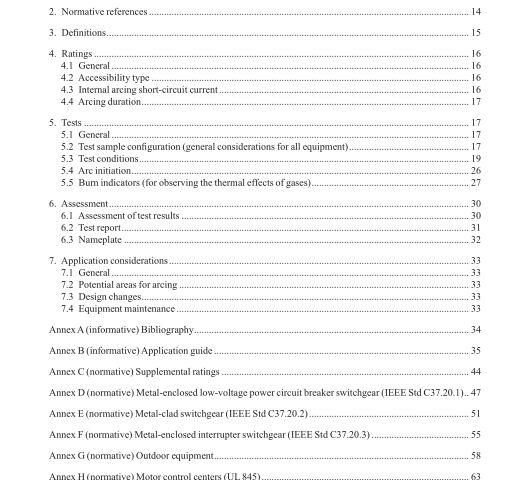IEEE C37.20.7-2017 pdf download.IEEE Guide for Testing Switchgear Rated Up to 52 kV for Internal Arcing Faults
This guide establishes methods by which equipment may be tested for resistance to the effects of arcing due to an internal fault. Equipment types covered in this guide include metal-enclosed switchgear as defned by IEEE Std C37.20.1™, IEEE Std C37.20.2™, IEEE Std C37.20.3™ and IEEE Std C37.20.9™; metal-enclosed bus as defned by IEEE Std C37.23™; medium-voltage ac controllers as defned by UL 347; motor control centers as defned by UL 845; switchboards as defned by UL 891; and metal-enclosed medium-voltage air- insulated circuit breakers for outdoor application defned by IEEE Std C37.04™ (see note).
This guide applies only to equipment utilizing air or other insulating gas as the primary insulation medium and rated 52 kV ac or below.
It applies to both indoor and outdoor equipment; however, special consideration should be given to the building size and construction for indoor applications (not fully addressed by this document).
The tests and assessments described in this guide are only applicable to arcing faults occurring entirely in air within the enclosure when doors and covers are properly secured in accordance with the rated accessibility type.
This guide does not apply to arcing faults that occur within components of the equipment, such as instrument transformers, sealed interrupting devices, fuses, and so on. Designs that meet the requirements of this guide will be referred to as arc-resistant.
NOTE—These circuit breakers are sometimes referred to as dead-tank circuit breakers.
1.2 Background
1.2.1 Consequences of internal arc faults Switchgear is designed to withstand the worst-case mechanical forces between conductors, which occur when a short circuit occurs directly on the load terminals of the switchgear.
This condition is referred to as a bolted fault, a short-circuit condition that assumes zero impedance exists at the point of the fault. The ability of switchgear to withstand the effects of the bolted fault is demonstrated in the short-time withstand current tests and the short-circuit current withstand tests as required by the specifc equipment standard or the corresponding tests in the relevant standards for other equipment types. When a bolted fault occurs, the voltage at the fault is essentially zero, and the fault energy is dissipated throughout the entire system from the source to the fault location.
The occurrence of arcing inside switchgear produces a variety of physical phenomena that are very different from the bolted fault. For example, the arc energy that results from an arc developed in air or other insulating gas will cause a sudden pressure increase inside the enclosure and localized overheating.
As a result, both severe mechanical and thermal stresses occur on the equipment. Moreover, the materials involved in or exposed to the arc may produce hot decomposition products, either gaseous or particulate, which may be discharged to the outside of the enclosure.
The procedures outlined in this guide make it possible to evaluate the effect of abnormal internal pressure acting on properly latched or secured covers, doors, inspection windows, and so on. The procedures also take into consideration the thermal effects of the arc on the enclosure and of ejected hot gases and glowing particles.
1.2.2 Equipment qualifed to this guide The use of equipment qualifed to this guide is intended to provide an additional degree of protection to the personnel performing normal operating duties in close proximity to the equipment while the equipment is operating under normal conditions. To qualify for an arc-resistant rating, the equipment shall fulfll the criteria in 6.1 of this guide in any state that exists during the equipment’s normal operations (refer to 5.4.2).
For the purpose of this guide, normal operating duties include operations such as opening or closing switching devices, connecting and disconnecting withdrawable parts, reading of measuring instruments and monitoring equipment, and so on.
Therefore, if performing any normal operation requires that any cover be removed and/ or any door be opened, the test described in Clause 5 shall be carried out with the cover and/or door removed. Removing or replacing active primary components (e.g., fuses or any other removable primary component) and activities required to carry out maintenance work are not considered to be normal operations. Such equipment cannot ensure total personnel protection under all circumstances that may exist at the time of an internal arcing fault. Furthermore, it is not intended to provide this additional degree of protection to operating personnel who in the normal performance of their duties would be required to alter the equipment from its normal operating condition. The areas where an additional degree of protection is provided for each accessibility type are defned in 4.2.IEEE C37.20.7 pdf download.IEEE C37.20.7-2017 pdf download
IEEE C37.20.7-2017 pdf download

Leave a Reply